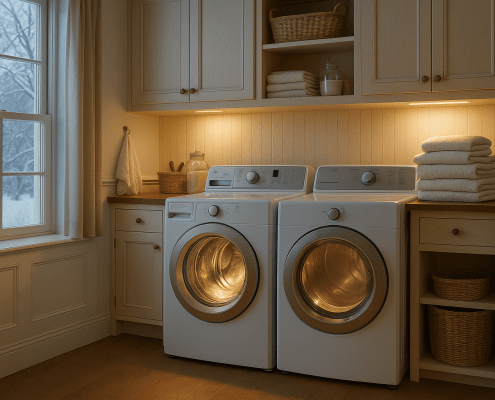Samsung Dryer Steam Valve Testing and Replacement Guide
Steven E / Thursday May 29, 2025
If your Samsung dryer’s steam function has stopped working, the steam valve assembly might be to blame. This component controls water flow to create steam, and when it fails, your dryer won’t deliver the results you expect. We’ll guide you through testing and replacing it so you can get your dryer back to full performance without a service call.
If you need any replacement parts for your Samsung dryer, you can enter your model number at AppliancePartsPros.com to order them. Most orders arrive in just two business days, and we have thousands of free guides to show you how to install your new parts.
The information in this article may not apply to your specific appliance model. We recommend consulting your manufacturer’s documentation or contact us with any questions.
What you need
- Multimeter
- Phillips screwdriver
The tools you need may vary based on your appliance model and its fasteners, so be sure to check the user manual or follow the manufacturer’s instructions for the right tools.
Safety precautions
When working on any appliance, remember to keep safety first. Here are some tips to keep in mind:
- Always power off and unplug your appliance or switch off the circuit breaker before you attempt any maintenance or replacement work. This keeps you safe by eliminating any risk of electric shock.
- If the appliance has recently been used, give it plenty of time to cool down before working on it.
- Take your time while working to prevent accidents and personal injuries. Rushing is the enemy of precision.
- Work in a well-lit area so you can see and access appliance parts.
- Keep your workspace free of clutter and other obstacles. Keep children and pets away from the work area.
- Never work on internal parts with wet hands. Make sure the work area is completely dry.
- Check the user manual to see if there are specific installation or safety instructions related to your appliance or replacement part.
- Be gentle when handling or removing parts. Excessive force might damage the appliance or cause personal injury.
- Wear insulated work gloves to protect your hands from sharp metal parts and debris.
- When working with wires, avoid touching any exposed wires or terminals. If you need to touch a wire, use a non-conductive tool or wear insulating gloves to prevent electrical shock.
- Always take photos or make a note of wiring terminals or other connections before disconnecting them to make reassembly easier.
- Don’t test live voltage with a multimeter if you’re unfamiliar with how to prevent short-circuiting.
- Consider wearing safety glasses and/or a dust mask when working with chemicals, dust, or a large amount of debris to prevent irritation or injury.
- Turn off the water supply at the outlet before beginning repairs. Keep towels ready to catch any residual water in the system when removing parts.
How to test and replace the Samsung dryer’s steam valve assembly
Follow these steps to test the steam valve for voltage and replace it if necessary to restore proper steam function in your Samsung dryer.
Step 1: Access the main control for testing
- Disconnect power by unplugging the power cord or turning off the circuit breaker.
- Use a Phillips screwdriver to remove the two screws securing the top panel at the back.
- Slide the top panel backward, lift it up, and set it aside.
- Remove the three mounting screws securing the main control housing to the front and side frame.
- Carefully rotate the main control to gain access to the wires.
- Make sure no bare wires are touching any metal.
- Let the housing rest on the frame of the dryer.
Step 2: Test the steam valve for voltage
LIVE VOLTAGE WARNING: For this test, the dryer needs to be plugged in and powered on. Please be very careful to protect yourself from electric shock, which has the potential to cause serious injuries. Don’t ever test live voltage if you’re uncomfortable using a multimeter.
- Plug the dryer’s power cord back in.
- Set a multimeter to Volts AC (V with a squiggly line).
- Place the black meter probe on the black wire of connection CN7 and keep it there.
- Use the red probe on the white wire of connection CN5 (to the right of CN7).
- Start a steam cycle and check for 120 Volts AC within two minutes.
- If voltage is present, move the red probe to the red wire of CN5 and check for the same reading.
- If no voltage is present at the red wire, wait another two minutes and check again.
- If voltage appears but steam does not enter the drum, the valve has failed.
Step 3: Remove the failed steam valve assembly
- Disconnect the wires behind the console on the right.
- Lift the console, pull it away from the dryer, feed the wires through the top bracket, and set it aside.
- Use a Phillips screwdriver to remove the two screws behind the door in front of the lint trap.
- Remove the four screws at the top of the front panel.
- Slightly lift the front panel, rotate it forward, and disconnect the door switch harness.
- Remove the front panel and set it aside.
- Remove the lint filter and unlatch the wire retainers from the wire harness.
- Disconnect the wires from the drum lamp.
- Use a Phillips screwdriver to remove the five screws from the top plate and set it aside.
- Remove the four screws from the front bulkhead and disconnect the sensor bar wire connector.
- Remove the screws securing the lint duct, pull the duct down, and set it aside.
- Reach back and remove the dryer belt from the idler pulley.
- Lift the front bulkhead up, pull it forward, and set it aside.
- Lift the drum off the rollers and remove the drum and belt, setting them aside.
- Move to the back of the dryer and remove the two Phillips screws securing the valve to the back panel.
- Remove the screws holding the vent access panel and set it aside.
- Remove the six screws securing the rear bulkhead to the back panel.
- Move the rear bulkhead out along with the steam valve assembly.
- Remove the nozzle mounting screws from the rear bulkhead.
- Disconnect the tubing from the valve and pull the nozzle section out of the rear bulkhead.
Step 4: Install the new steam valve assembly
- Feed the tubing through the rear bulkhead.
- Secure the nozzle with the Phillips screws removed earlier.
- Insert the tubing into the valve and make sure it is fully seated.
Step 5: Reassemble the dryer
- Secure the rear bulkhead onto the frame using the six Phillips screws.
- Reach through the vent access to hold the valve in place and attach it using the two Phillips mounting screws.
- Reinstall and secure the vent access panel.
- Install the drum and belt and secure the belt onto the motor and idler pulley.
- Install the front bulkhead and secure it using the Phillips screws removed earlier.
- Reconnect the sensor bar wires.
- Install the lint filter housing and reconnect the drum lamp wires.
- Install the top plate and secure the wire harness with the retainers.
- Guide the front panel onto the bottom hinges, connect the door switch wires, and rotate the panel into place.
- Secure the front panel with the screws removed behind the door and at the top.
- Set the console back in place, guide the wires through the top plate, and push the console into position.
- Connect the console wires.
- Secure the control using the three Phillips screws removed earlier.
- Slide the top panel onto the dryer and secure it with the final two Phillips screws.
- Plug the dryer back in or turn the breaker back on.
Find more DIY resources
Thanks for reading! We hope this guide helped you test and replace the steam valve assembly in your Samsung dryer.
If you still need some replacement parts, grab your model number and head over to AppliancePartsPros.com. We have over two million parts in stock and most orders arrive in two business days. If you need some help with finding the right part or placing an order, you can contact our team at 1 (877) 477-7278.
While you’re waiting for your new part to arrive, you can explore our DIY blog and watch thousands of video tutorials on our YouTube channel.
Follow us on Facebook, X and Instagram to see our latest repair guides!
With nearly a decade of experience in providing top-notch customer service regarding appliance parts and repair, Steven enjoys sharing practical advice, troubleshooting tips, and interesting information to help readers stay informed.





